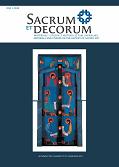Ex oriente lux. Recepcja ikony w sztuce polskiej (lata 1960–2007)
Ex oriente lux. Reception of the icon in Polish art (1960–2007)
Author(s): Renata Rogozińska Subject(s): Cultural history
Published by: Wydawnictwo Uniwersytetu Rzeszowskiego
Keywords: contemporary art; Polish artists; icon; inspirations
Summary/Abstract: Given the widespread interest in the icon in the 20th century – in its form, profundity, rich religious content, and the aura of spirituality – it is hardly surprising that it also became an important source of artistic inspiration, multiple examples of which can be found in Polish art, especially that of the last 50 years. In the 1960s, artists such as Kazimierz Głaz, Józef Hałas, Henryk Musiałowicz, Jerzy Nowosielski, Wojciech Sadley, Jan Berdyszak, and Witold Damasiewicz initiated the revival of interest in Orthodox church art, different from that of the interwar period. In the following decades, Orthodox motifs, variously modified, were often taken up by Zbigniew Bajek, Ewa Kuryluk, Tadeusz Brzozowski, Magdalena Dmitruk, Eugeniusz Mucha, Alina Szapocznikow, Aldona Mickiewicz, Zbigniew Treppa, Romuald Oramus, Anna Myca, Marek Sobczyk, Christos Mandzios, Krzysztof Klimek, Magdalena Daniec, Leon Tarasewicz, Andrzej Bednarczyk, Ignacy Czwartos, Andrzej Desperak, Jacek Dłużewski, Tadeusz G. Wiktor, Marian W. Kuczma, Adam Molenda, and Władysław Podrazik. The work of all these artists is presented against different problematic backgrounds, including the martial state in Poland and the related movement of independent culture. As far as the popularization of the icon is concerned, the influence of Jerzy Nowosielski deserves a special mention, and in particular his art, his theological reflection, and his aesthetics. It is also important to discuss the broader European background of the revival, especially the art of the Russian avant-garde. The article argues that the inspiration drawn from the icon cannot be reduced to a superficial exercise in archaization. To the contrary, icons provoke artists to engage in various transpositions and create innovative solutions, which are often remote from the original and bear a clear mark of individuality. Borrowings such as the frontal presentation of figures, two-dimensional space, reversed perspective showing a divine rather than human point of view, luminosity, colour scheme and geometry, richness of materials, and, finally, painting technique, are used to “inject a drop of the sacred” into the bloodstream of the work of art. In view of the secularization process, references to the icon often come as a rejection of “culture turning into a desert” and an effort to reclaim the supernatural perspective.
Journal: Sacrum et Decorum. Materiały i studia z historii sztuki sakralnej
- Issue Year: 2009
- Issue No: 2
- Page Range: 49-81
- Page Count: 33
- Language: Polish

